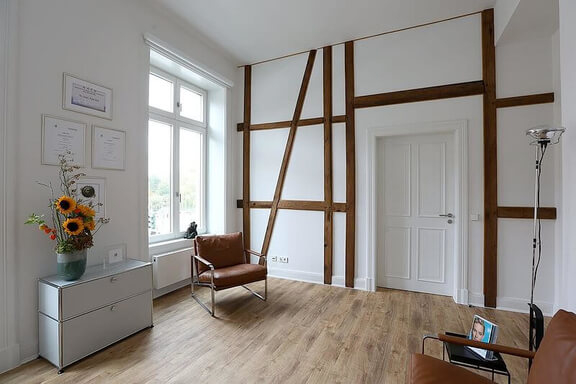Facts on Ear Surgery
| Duration: | appx. 1 hour per side |
|---|---|
| Anesthetization: | local anaesthesia / Kids get a general anaesthesia |
| Treatment: | ambulant |
| Strapping: | no bandage necessary, just a headband at night |
| Stitch removal: | no stitches |
| Down time: | 2 weeks / less with a head strapping |
Protruding ears - large ears, setting the ears back - having them reduced
Ears are there for hearing. But they are far more than that as well. Big ears, small ears, with earrings or without: Our ears frame our face.
Large or protruding ears take our attention away from the face, which many people find unpleasant and upsetting.
But there’s no need to resign ourselves to it. We can fix the situation by having our ears set back or reduced in size, or with the help of other corrective ear surgeries. Demand for corrective otoplasty exists within practically every age group, from children to senior citizens.
SURGICAL TECHNIQUE - CHONDROPLASTIC TECHNIQUE (TECHNIQUE MODIFIED BY RAUNIG AND ARLT)
Here at our practice in Hamburg, cartilage reshaping techniques (known as chondroplastic techniques) have proven especially effective for otoplasty. We worked with colleagues to modify this technique and develop it further (less-invasive cartilage reshaping technique, modified by Dr. Raunig and Dr. Arlt).
Our modified method does not involve operating on the backside of the ear. Instead, we use a small, hidden incision underneath the edge of the helical rim, and detach only a small amount of skin to create a kind of tunnel. We use special diamond files to thin out and reshape the cartilage in front, which causes the cartilage to move in the desired direction and take the desired shape right there during the procedure. During the initial healing phase (two weeks), we secure the new ear shape using a specially fixed bandage. The bandage is narrow and can easily be hidden under, for example, a headband or cap.
Advantages: Limited skin mobilization ensures that crucial circulation is preserved throughout the backside of the ear. Weakens the cartilage’s internal tension, making it possible to bend the cartilage back accordingly. Natural ear shape. No retention sutures, so no suture-related risk of infection or immune system reactions.
Disadvantages: Challenging surgical technique. Requires special instruments. Comparatively lengthy operation - around one hour per side.
SURGICAL TECHNIQUE - SUTURING TECHNIQUE
Very soft and flexible ear cartilage can be brought into the desired position using several stitches on the back of the outer ear (e.g., technique modified by Mustardé).
Advantages: Relatively simple, low-risk method.
Disadvantages: The shape of the ear does not always look natural. Only usable on soft cartilage; firm cartilage is difficult to shape using sutures alone, and will not hold the shape well long-term. Because the cartilage maintains its internal tension, the sutures may loose their hold, causing the ears to protrude again (relapse). Sutures are foreign bodies and may cause problems with wound healing or trigger immune system reactions.
Modification: Suture techniques plus cartilage thinning
Thinning the cartilage out, for example using a diamond burr, can weaken it and make it easier to shape.
Advantages: This makes it possible to use the suturing technique on somewhat firmer cartilage as well.
Disadvantages: as before.
SURGICAL TECHNIQUE - INCISION AND SUTURING
This technique is commonly used by many surgeons. It involves reshaping firmer cartilage by making precisely placed incisions on the backside of the ear and then suturing (e.g., technique modified by Converse).
Advantages: Allows reshaping of firmer cartilage.
Disadvantages: The shape of the ear does not always look natural. If absorbable sutures are used, the remaining internal cartilage tension can cause the ears to protrude again (relapse). Sutures are foreign bodies and may cause problems with wound healing or trigger immune system reactions.
SURGICAL TECHNIQUE - SCORING TECHNIQUE
The skin is detached from the front side of the outer ear using a hidden incision in order to create a kind of tunnel. The front of the ear is then delicately scored so that the cartilage can be bent back (e.g., technique modified by Stentström).
Advantages: Weakens the cartilage’s internal tension, making it possible to bend the cartilage without sutures to hold it in place.
Disadvantages: Cannot precisely predict the degree to which the cartilage will bend.
SURGICAL TECHNIQUE - ROTATION TECHNIQUE
After removing the connective tissue behind the ear, the ear can be brought closer to the head.
Advantages: Very useful method in combination with the above named antihelical techniques. Disadvantages: When this technique is used on its own (which unfortunately is not a rare occurrence), the upper part of the ear and the earlobe protrude, while the middle part is often set too close (“telephone ear”). This makes the ear look unnatural.
SURGICAL TECHNIQUE - EARLOBE OR EAR SIZE REDUCTION
If only the earlobe is enlarged, e.g., through heavy jewelry, this is comparatively easy to correct.
If the entire ear is enlarged, whether through genetics or as a result of the natural aging process, the cartilaginous skeleton of the outer ear needs to be made smaller. This is always associated with a certain degree of effort, and cannot be done without scarring.
At our practice in Hamburg, we use an ear size reduction technique that allows us to not only make the ear smaller, but also place it closer to the head at the same time if necessary.
FOLLOW-UP OPERATIONS AND MULTI-STAGE EAR OPERATIONS
Revision otoplasty
So-called revision operations pose special challenges to the surgeon’s capabilities and sensitivity. For one thing, the previous operation(s) has/have changed the anatomy of the ear, and the initial situation is often made more difficult due to scarring or tissue defects and the associated cartilage ridges. For another, patients whose first operations did not go as desired are often in a tense frame of mind. They frequently want to “get the operation over with as soon as possible” so that they can “finally look normal”.
The first challenge is to eliminate prior damage and/or consequences of the previous operation(s) to the greatest possible extent. The results achievable through revision surgery depend on the nature of the initial situation, but surgeons well-versed in this type of surgery my at least manage to make improvements.
Reconstructive otoplasty
Defects and noticeable scars caused by injuries, accidents, tumors or malformed ears can be very troublesome. The purpose of reconstructive plastic surgery is to eliminate noticeable abnormalities, and to restore the original state or provide “normality” as much as possible.
We would be happy to meet you at our practice in Hamburg to discuss your individual situation, develop a treatment approach suited to your needs, and evaluate the achievable results. These meetings help you learn more about the possibilities and limits involved in your individual situation, and also meet your treating physician face-to-face. We would be glad to arrange an in-person consultation with you.
SETTING EARS BACK – ONE SURGICAL TECHNIQUE IS NOT ENOUGH!
Many surgeons set ears back using one specific technique that they once selected. Oftentimes their method of choice is a comparatively simple one. Naturally, this can help save surgery time and reduce expenses, but correcting the size, shape and position of the outer ear is actually a complex matter.
It is not without good reason that there are a wide variety of techniques for this procedure, which demonstrates one thing in particular: there’s no single surgical technique for all ear shapes and sizes. As pleasant as the idea of “one-technique-fits-all” is, in reality it’s unfortunately too simplistic.
Rather, certain techniques are suited to certain outer ear shapes, or to certain types of changes, and less suited to others. The key factor in planning and preparing for corrective otoplasty is you. The nature of your ears, that is.
The strength of your auricular cartilage is of crucial importance in determining which surgical technique will be most appropriate, and whether that technique will need to be modified to fit your particular circumstances.
No matter if the ears in question are yours or your child’s, it is important that your surgeon of choice has a variety of surgical methods at his disposal. After all, protruding ears can be caused by a number of different factors.
Contact
Dr. Axel Arlt
Practice community
Esplanade 31 / Ecke Stephansplatz
D - 20354 Hamburg
Phone: +49 (0)40 - 413 55 66 9
Mail: info@dr-axel-arlt.de


